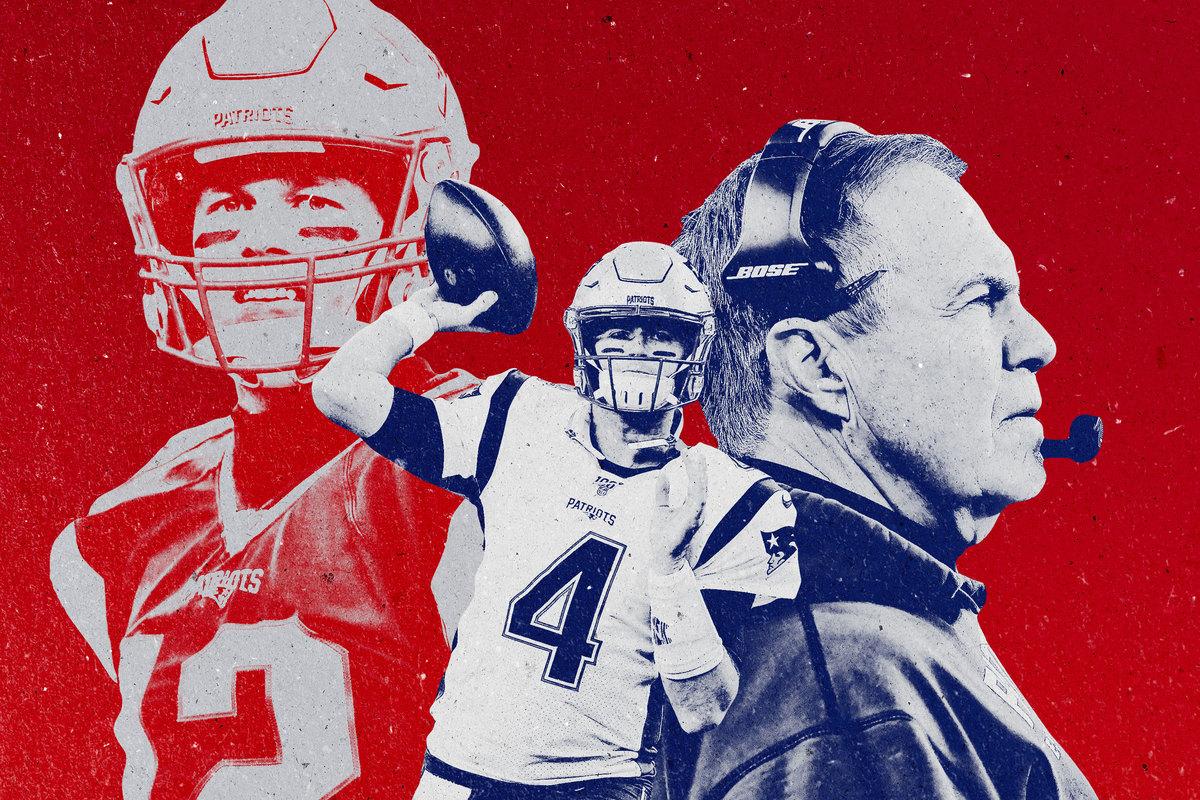
What’s most clear about the 2020 Patriots is how different they’ll be from last year’s team. Tom Brady signed with Tampa Bay in free agency and left a $13.5 million salary-cap charge on New England’s books as a parting gift. Bill Belichick often passes on the big-ticket free agents anyway, but with little to spend this offseason, and a slew of expiring contracts, he couldn’t have made a splashy signing even if he’d wanted to. This was especially notable at quarterback, where the Patriots added … Brian Hoyer and two undrafted free agents.
Financial restrictions aside, many still thought the Patriots would do more. Privately, several Patriots players wondered whether the team would sign Teddy Bridgewater in free agency, though he ended up signing with the Panthers. There was media speculation about Andy Dalton, who wound up with the Cowboys. The Patriots didn’t trade up for Tua Tagovailoa and passed on Jordan Love; instead, they traded out of the first round and took a Division II safety, Kyle Dugger, as their highest pick in the draft. Whether via the draft, free agency, or a trade, New England passed on all the boldface names in favor of value, versatility, and special teams potential.
It was all pretty typical, but it was fair to look at New England’s offseason and wonder whether it met the moment. The “c’mon, do something” meme made the rounds. The franchise’s greatest player had left, and it seemed like Belichick’s priority was not to upset the compensatory pick formula.
It’s in part a show of faith in Jarrett Stidham, Brady’s backup last season, who’s thrown four NFL passes in his career. But it’s also a show of faith in a path the Patriots have been on for the past couple of years, one that emphasizes their running game and relies on their defense, while asking the quarterback not to mess it up. A narrow view might make New England’s offseason seem like a disproportionate response to Brady’s departure, but the moves fit more neatly into a longer-term plan when you widen the lens. One of the fascinating story lines of the 2020 season will be how Belichick and the Patriots reinvent themselves post-Brady, but the reinvention is part of a long-term project, and it will not be completed in one season.
“The team was constructed very competitively,” Belichick said in January after New England’s AFC wild-card loss to Tennessee. “I think that was reflected in our overall play during the course of the year. Again, we lost four games that basically came down to the last possession, other than the Baltimore game, which, that was a pretty competitive game, too.”
Belichick sounded stubborn and was as close to excuse-making territory as he gets. The Patriots lost to the Ravens by three scores. The message came through clearly, though, that there had been plenty of elements of the 2019 team that Belichick would not abandon as failures.
On offense, it begins with the running game. The Patriots offense has been quietly reshaped for the last two years to prepare for Brady’s decline and his eventual departure. In 2018, New England refocused its offense around its running game and finished with the NFL’s fifth-best rushing attack. That output increased in the playoffs as the Patriots scored nine rushing touchdowns, including the decisive score against the Rams to win Super Bowl LIII.
That offense wasn’t replicated in 2019, though that was due to circumstance, not design. New England’s starting center, David Andrews, missed the year because of blood clots in his lungs, and fullback James Develin played only two games because of a neck injury that sent him to injured reserve and then an early retirement this offseason. Develin was in for more than 40 percent of the offensive snaps in six of the Patriots’ last nine games in 2018 and was the lead blocker for all nine rushing touchdowns in that season’s playoffs. The hit the 2019 offense took when it lost him was made obvious by how hard the team tried to replace him.
When Develin got hurt, the only other fullback the Patriots had was Jakob Johnson. They had a roster exemption to keep Johnson, of Stuttgart, Germany, as an extra member of their practice squad through the International Player Pathway Program, a little-known league initiative to get players from other countries on teams. When Johnson was promoted after Develin’s injury, he became the first player in league history from that pipeline to make a 53-man roster.
Then Johnson got hurt, too, and Belichick started pulling players from other positions for fill-in fullback duty. Linebacker Elandon Roberts, tight ends Eric Tomlinson and Ben Watson, and offensive lineman James Ferentz all got the call. Belichick is famously fond of telling players he could pop down the street to Foxborough High School and find their replacements as a dig, but at some point last season, this was verging on becoming a legitimate contingency.
What was not seriously considered was simply running an offense that, like the majority of NFL teams, didn’t use a fullback.
“We needed a fullback,” Patriots running backs coach Ivan Fears told me last December. “We needed to be able to keep the scheme going.”
It appears they’ll keep it going into 2020. The Patriots signed fullback Danny Vitale in free agency and drafted a tight end, Dalton Keene, who lined up in the backfield at times at Virginia Tech. Andrews has been medically cleared to play football again and Belichick broke form this offseason by using the franchise tag to keep stellar left guard Joe Thuney on the team. All this may not be enough to re-create the running game they had going in 2018, but they’re making an effort to improve on last season, when they were 25th in the NFL in yards per rushing attempt.
Revitalizing the run game would take the pressure off of whomever Belichick chooses as the starting quarterback, likely Stidham or Hoyer, and will help keep what’s still a very good defense fresh. As was the case last season, the Patriots’ best chance to win games in 2020 is to have their defense continue to play well.
One of the most telling moments of the 2019 Patriots season came last October just after New England had cut Watson (they would wind up re-signing him later in the season).
“There wasn’t a roster spot,” Belichick said as an explanation.
This came when the Patriots had next to no one they could rely on at tight end. They’d struck out with Jared Cook, Austin Seferian-Jenkins, and Lance Kendricks and were left with an injured Matt LaCosse and Ryan Izzo. At that point, those two players had a combined seven catches in five games and Brady was bringing up the difficulty of playing with younger skill position players at what seemed a deliberate frequency. This was the context within which the Patriots, who have made tight end central in their offense for a decade, felt they had no space for Watson.
On the same day in the same press conference, Belichick seemed downright gleeful about the depth of the defense.
“We rotate a lot. We’ve played 20 players on defense the last four or five weeks,” Belichick said. “Naturally, you start splitting it up between 20 guys, that’s what you’re going to get. Show me how many teams in the league play 20 players on defense. Not too many.”
At the same moment Belichick claimed his second tight end was unnecessary, he also deemed his sixth and seventh edge rushers essential. This attitude is a window into how Belichick has been building the Patriots roster in recent years. The 2019 roster was built to win with a defense that Belichick ran with two trusted assistants, his son Steve Belichick and linebackers coach Jerod Mayo, a beloved former player.
With a deep and versatile group of linebackers and an experienced secondary, the Patriots ran nearly anything they wanted and shapeshifted during games with or without substituting players. One of the scarcest resources in the NFL is practice time, and the Patriots defense exploited this by being impossible to define and, therefore, hard to prepare for. For half a season, they were on a historic course. It’s easy to see why Belichick would want to run it back in 2020, even if it means, as it has, using cap space and draft picks to restock at safety and linebacker when the needs on offense look more dire.
It’s typically useless to guess what Belichick will do in a given situation, but building a balanced offense around the running game and pouring resources into an elite defense are things he’s already doing. There is a plan here.
One note about plans: Some don’t work. Emphasizing the ground game and relying on the defense didn’t work in 2019, at least not by Patriots standards. The historic pace the defense was on in the first half of the season seemed less impressive after New England lost to every AFC playoff team not from Buffalo.
And now, they don’t have Brady. Belichick asked less of Brady in recent years and built his roster accordingly. But Brady’s presence meant Belichick could trust that the Patriots offense could overcome its shortcomings and remain competent. Stidham, if he ends up the starter, is a complete unknown. Belichick could rely on Brady to limit turnovers. If Stidham throws a lot of interceptions, he’ll cut any game plan off at the knees.
So, this is not to say that Belichick is playing three-dimensional chess—going from Brady to Stidham or Hoyer will make it harder to win games—but he’s not playing blindfolded darts, either. To understand New England’s offseason, you have to look beyond the last few months, back to 2018. The Patriots do not do everything right, but they do not do anything on a six-month timeline, building the 2020 team included.

